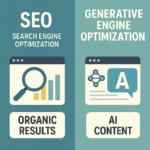E-E-A-T Principles for AI-Driven Search Success
In the evolving landscape of AI-driven search, the principles of E-E-A-T (Experience, Expertise, Authoritativeness, and Trustworthiness) have taken on renewed importance. Originally developed as guidelines for human search quality raters, these principles now play a crucial role in how AI systems evaluate and prioritize content. This article explores how marketers can implement E-E-A-T principles specifically for success with generative AI search engines. Want to go deeper into principles of AI-driven search? Sign up for our Generative Engine Optimization Course.
Understanding E-E-A-T in the Context of AI Search
E-E-A-T represents the criteria that both human evaluators and AI systems use to assess content quality and reliability. Let’s examine each component and its specific relevance to AI-driven search:
Experience
The newest addition to the framework, Experience emphasizes the value of first-hand or life experience with a topic. AI systems increasingly differentiate between content that demonstrates genuine experience versus theoretical knowledge.
Why it matters for AI search:** Generative AI models are trained to recognize linguistic patterns that signal genuine experience, such as specific details, practical insights, and authentic perspectives that can’t be easily synthesized without direct experience.
Expertise
Expertise refers to the specialized knowledge or skill demonstrated in the content. For AI systems, expertise is assessed through the depth, accuracy, and technical precision of information presented.
Why it matters for AI search:** AI models are trained on vast corpora of expert content and can recognize the hallmarks of expertise in specific domains. They can identify when content reflects current understanding in a field and when it contains outdated or superficial information.
Authoritativeness
Authoritativeness considers the reputation of the content creator, brand, or website in their specific field. For AI systems, authoritativeness is evaluated through recognition patterns and contextual understanding.
Why it matters for AI search:** AI models have been trained on content that references authoritative sources and can recognize when content is associated with established experts or institutions in a field. They can also identify citation patterns that signal authority.
Trustworthiness
Trustworthiness encompasses accuracy, transparency, and the overall integrity of the content. For AI systems, trustworthiness is assessed through consistency, citation practices, and alignment with established knowledge.
Why it matters for AI search:** AI models are increasingly sophisticated at detecting potential misinformation, unsupported claims, and content that contradicts scientific consensus. They prioritize content that demonstrates transparency and rigorous sourcing.
How AI Systems Evaluate E-E-A-T Differently
While the fundamental principles of E-E-A-T apply to both traditional and AI-driven search, there are important differences in how AI systems evaluate these qualities:
Contextual Understanding vs. Signal Counting
Traditional search algorithms often rely on counting specific signals (like backlinks or keyword usage) as proxies for quality. In contrast, AI systems can understand content in context, evaluating E-E-A-T through deeper linguistic analysis and pattern recognition.
For example, an AI system might recognize expertise not just through credentials stated in an author bio, but through the nuanced way a topic is discussed, the appropriate use of technical terminology, and the logical structure of arguments.
Cross-Reference Capabilities
AI systems can effectively cross-reference information across vast datasets, allowing them to verify factual claims and identify inconsistencies more effectively than traditional algorithms.
This means that trustworthiness is increasingly evaluated based on how well content aligns with established knowledge across multiple authoritative sources, rather than simply checking for external links or citations.
Linguistic Nuance Detection
AI systems can detect subtle linguistic patterns that signal experience and expertise—or their absence. They can identify when content uses appropriate hedging (acknowledging limitations or uncertainties) versus making inappropriately absolute claims.
They can also recognize narrative structures that indicate firsthand experience versus theoretical knowledge, even when not explicitly stated.
Implementing E-E-A-T for AI Search Success
Based on these differences, here are specific strategies for implementing E-E-A-T principles to optimize content for AI-driven search:
- Demonstrate Experience Through Specific Details
AI systems can distinguish between generic information and content informed by genuine experience. To signal experience to AI:
- Include specific, detailed examples** that could only come from direct experience
- Share practical insights, challenges, and solutions** rather than just theoretical information
- Use first-person narrative where appropriate** to describe direct experiences with the subject matter
- Incorporate sensory details and observations** that add authenticity to descriptions
- Discuss how approaches have evolved over time** based on accumulated experience
Example: Rather than simply stating “email marketing is effective for customer retention,” share specific observations like “After implementing a three-stage re-engagement sequence with our inactive subscribers, we observed a 34% increase in repeat purchases over six months, with particularly strong results from customers who had been inactive for 30-60 days.”
- Signal Expertise Through Depth and Precision
AI systems evaluate expertise based on the depth and precision of information provided. To signal expertise to AI:
- Provide comprehensive coverage of topics, addressing multiple dimensions and considerations
- Use domain-specific terminology accurately while still making content accessible
- Explain complex concepts clearly, demonstrating both understanding and communication skill
- Address nuances and exceptions rather than making oversimplified generalizations
- Incorporate current research and developments to demonstrate up-to-date knowledge
Example: When discussing SEO strategies, don’t just recommend “creating quality content.” Instead, explain the specific attributes that define quality from a search perspective, such as comprehensive topic coverage, appropriate semantic structure, user engagement metrics, and how these factors interact with different types of search intent.
- Establish Authoritativeness Through Recognition and Association
AI systems assess authoritativeness based on recognition patterns and associations. To signal authoritativeness to AI:
- Clearly display relevant credentials and qualifications of content creators
- Highlight industry recognition, certifications, and awards that establish authority
- Reference your own previously published work or research where relevant
- Include endorsements or collaborations with recognized authorities in your field
- Maintain consistent subject matter focus to build topical authority over time
Example: For a medical article, clearly identify the author as “Dr. Sarah Johnson, Board-Certified Cardiologist with 15 years of clinical experience and over 30 published research papers on cardiovascular health,” rather than simply “Sarah Johnson, Medical Writer.”
- Build Trustworthiness Through Transparency and Verification
AI systems evaluate trustworthiness based on transparency, verification, and alignment with established knowledge. To signal trustworthiness to AI:
- Cite reputable sources with specific attributions rather than making unsupported claims
- Use structured data and schema markup to clearly identify content types and attributes
- Disclose potential conflicts of interest and commercial relationships
- Acknowledge limitations and uncertainties in current knowledge
- Update content regularly to reflect current understanding and correct any outdated information
Example: When discussing the effectiveness of a marketing approach, explicitly state “According to a 2024 study published in the Journal of Marketing Research (Smith et al., 2024), this approach increased conversion rates by an average of 23% across 150 e-commerce websites,” rather than making an unattributed claim that “studies show this approach works well.”
- Implement Structured Information Architecture
AI systems better understand and evaluate content that is logically structured. To improve E-E-A-T signals through structure:
- Use clear, descriptive headings that create a logical hierarchy
- Implement appropriate schema markup to identify content types and attributes
- Create explicit connections between related concepts to demonstrate comprehensive understanding
- Use formatting to highlight key information and improve readability
- Organize content in a progression that builds understanding from foundational to advanced concepts
Example: Structure a guide on digital marketing with clear hierarchical headings that progress from fundamental concepts to specific tactics, with appropriate schema markup identifying it as an educational article with specific subtopics covered.
- Provide Context and Relationships
AI systems excel at understanding relationships between concepts. To strengthen E-E-A-T through contextual understanding:
- Explain how concepts relate to each other and fit into broader frameworks
- Compare and contrast different approaches to demonstrate nuanced understanding
- Provide historical context and evolution of ideas or practices
- Connect specific tactics to broader strategies and underlying principles
- Explain why certain practices work, not just what they are
Example: When discussing a marketing tactic, explain how it fits into broader marketing strategy, how it has evolved over time, how it compares to alternative approaches, and the psychological or business principles that explain its effectiveness.
- Demonstrate Comprehensive Topic Coverage
AI systems can assess how thoroughly a topic is covered. To signal expertise and authoritativeness through comprehensiveness:
- Address multiple dimensions of a topic, including different perspectives and applications
- Anticipate and answer likely questions readers might have
- Include both fundamental and advanced information to serve different knowledge levels
- Cover potential exceptions, limitations, and special cases
- Provide practical implementation guidance alongside theoretical knowledge
Example: A comprehensive guide on email marketing would cover strategy, list building, segmentation, copywriting, design, automation, analytics, compliance, and integration with other channels—not just one or two of these aspects.
Measuring and Improving E-E-A-T for AI Search
Evaluating and enhancing your content’s E-E-A-T for AI search requires systematic assessment and improvement:
- Conduct an E-E-A-T Audit
Systematically evaluate your existing content against E-E-A-T criteria specifically for AI readiness:
- Experience: Does the content include specific details and insights that demonstrate firsthand experience?
- Expertise: Does it provide depth, precision, and up-to-date information that signals subject matter expertise?
- Authoritativeness: Are author credentials clearly displayed? Does the content reference recognized authorities and established knowledge?
- Trustworthiness: Is information properly sourced and cited? Does it acknowledge limitations and avoid overgeneralizations?
- Prioritize Improvements Based on Content Purpose
Different types of content may require emphasis on different E-E-A-T elements:
- YMYL (Your Money or Your Life) content should prioritize expertise and trustworthiness through rigorous sourcing and clear credentials
- How-to and instructional content should emphasize experience and practical application
- Thought leadership content should focus on demonstrating unique expertise and authoritative perspective
- News and current events should prioritize trustworthiness through verification and balanced reporting
- Implement Structured Testing
Test how well AI systems understand and utilize your content:
- Use AI-driven search tools to query topics covered in your content and see if your material is referenced
- Test content with generative AI systems to see how they interpret and summarize your information
- Analyze which sections of your content are most frequently cited or referenced by AI systems
- Compare AI interpretation of your content against your intended messaging
- Develop an E-E-A-T Enhancement Plan
Based on audit and testing results, create a systematic plan to enhance E-E-A-T signals:
- Update author profiles to more clearly communicate relevant expertise and experience
- Enhance citation practices with more specific attributions and references
- Add experiential details to content that lacks firsthand perspective
- Improve content structure to better communicate relationships between concepts
- Implement appropriate schema markup to clarify content attributes for AI systems
Conclusion: E-E-A-T as a Foundation for AI Search Success
As AI-driven search continues to evolve, E-E-A-T principles provide a robust framework for creating content that will be valued and prioritized by these systems. By implementing the strategies outlined in this article, marketers can ensure their content demonstrates the experience, expertise, authoritativeness, and trustworthiness that AI systems are increasingly designed to recognize and reward.
The most successful approach combines technical optimization with a genuine commitment to creating valuable, authoritative content. Rather than viewing E-E-A-T as simply another set of optimization tactics, marketers should embrace these principles as fundamental guidelines for creating content that serves both human readers and AI systems by providing genuine value and insight.
By focusing on demonstrating real experience, showcasing genuine expertise, establishing clear authoritativeness, and maintaining rigorous trustworthiness, marketers can position their content for success in the emerging era of AI-driven search.
To learn more about implementing effective E-E-A-T strategies for AI search success, explore our comprehensive GEO course, which provides in-depth guidance on optimizing content for generative AI systems.





